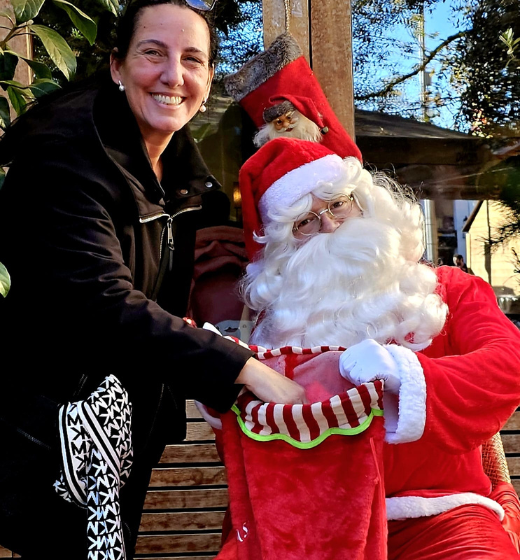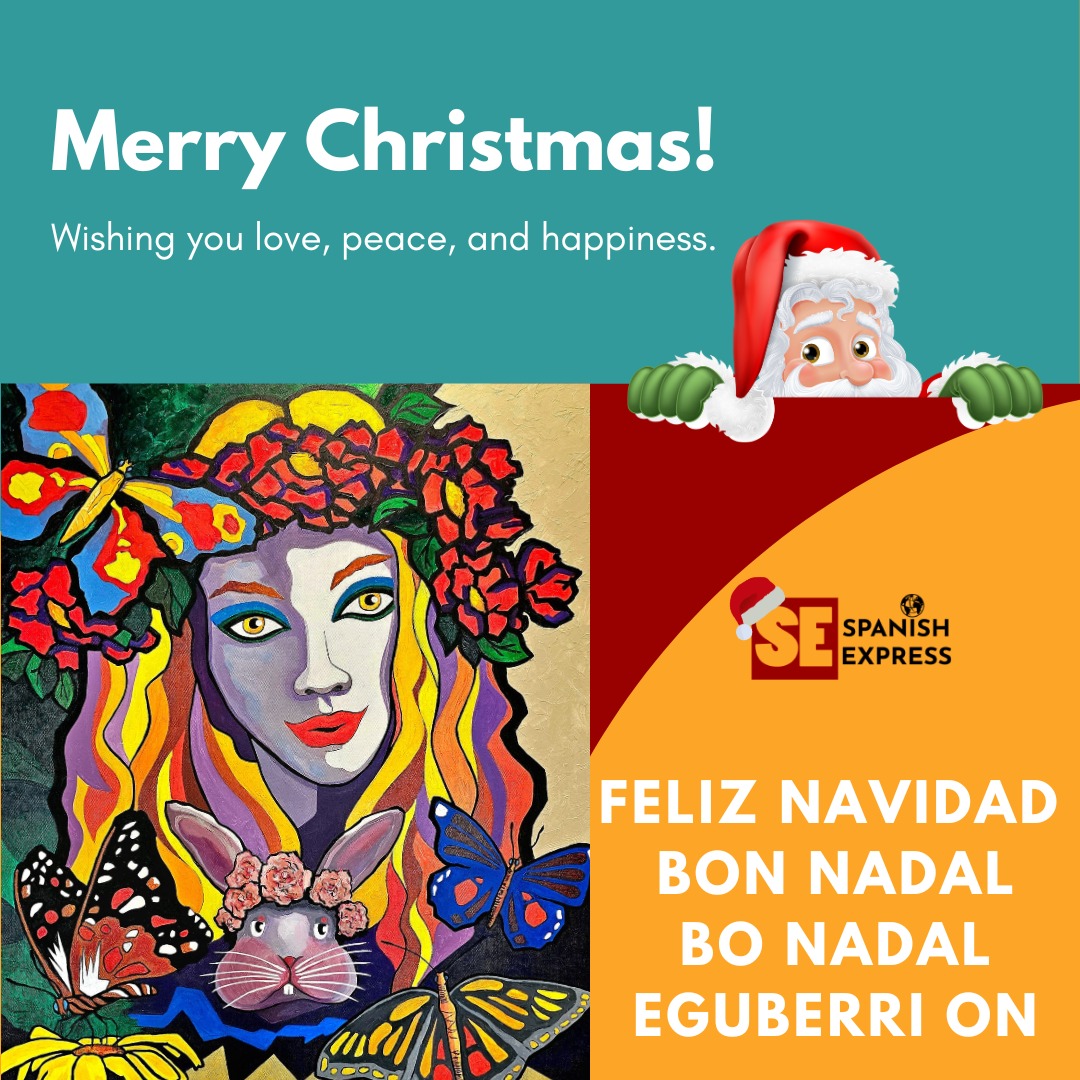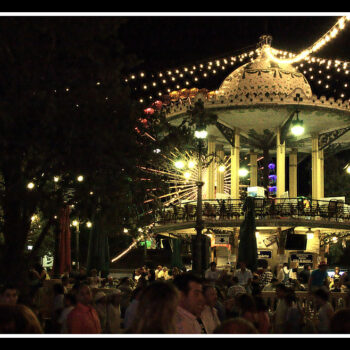

Spanish holidays blend elements of both Christian and pagan traditions. In adherence to Catholic beliefs, Christmas is observed on 25th of December to commemorate the birth of Jesus. New Year’s Eve, known as Nochevieja in Spanish, falls on 31st of December, marking the moment to bid farewell to the concluding year and usher in the new one.
Christmas in Spain, known as ‘Navidad‘, is celebrated with a series of unique traditions and festivities.
This article explores how the festive Christmas season unfolds in Spain, starting from the ‘Feast of Immaculada‘ on 8th of December to the ‘Feast of Epiphany‘ on 6th of January.
We look at key aspects of the Spanish Christmas experience, including the ‘El Gordo’ lottery (the fat one), the family-centered celebration of ‘Nochebuena‘, the customs of Christmas Day, and the vibrant Christmas markets.

These traditions highlight Spain’s distinct approach to celebrating this Christmas holiday, focusing on family, community, and cultural heritage.
This celebration in Spain only begins during the second half of the month of December. During this period, the streets and towns are decorated with Christmas adornments.
Customs, Traditions & celebrations
On the 22nd of December, the Spanish Christmas lottery is drawn and everyone in Spain purchases lottery tickets just to win the ‘El Gordo‘.
Christmas Eve or ‘Nochebuena‘ is a special day when Spanish folks attend the ‘Mass of Rooster’ (La Misa del Gallo) at church and then families return home to spend quality time with their family and friends. On this day, people prepare a grand feast and they sing Christmas carols.
Christmas Day is a joyous occasion where families gather to share a festive meal, fostering an atmosphere of togetherness. This day is marked by numerous reunions with extended family and friends, creating a warm and celebratory ambiance. Particularly in households with young children, the focus often shifts to discovering the surprises brought by Papá Noel (Santa Claus). The streets come alive with the sounds of laughter and excitement as children eagerly try out their new gifts.
The 5th of January the streets come alive with parades featuring elaborately adorned floats, where the Three Wise Kings make their grand entrance, captivating the hearts of both young and old.
The ‘Feast of Epiphany‘ is held on 6th of January and on this day; children in Spain receive gifts from the ‘Three Wise Men‘. Scroll further to learn more interesting information about Christmas in Spain.
On the morning of 6th of January, excitement fills the air as children awaken to discover the thoughtful gifts left by Melchior, Caspar, and Balthazar, the legendary Magi.
The Tradition of ‘El Gordo‘

On 22nd of December, a Christmas lottery is held as a part of the celebrations. People in Spain buy tickets in the hope to win the ‘El Gordo‘ (the biggest prize), along with obtaining small prizes.
Apart from being a traditional festive, the ‘El Gordo‘ is also a matter of pride and prestige for the people of Spain.
Spanish Nativity Scene
During December, people assemble a model manger with carved figures of the Holy family, the angels, the Three Kings, shepherds, and animals to form the Nativity scene or ‘Nacimento‘.
Spanish families gather around the manger to sing, while the children dance and play the tambourines. The people in Spain respect and honour the cow as they believe that Baby Jesus was warmed by the cow’s breath.
Hence, the cow is also revered, while setting up the Nativity Scenes.
‘Nochebuena’
‘Nochebuena,’ gracefully translating to ‘the Good Night’ encapsulates the essence of Christmas Eve in Spain, transforming it into a cultural symphony where time-honored customs and contemporary celebrations coalesce.
As the stars emerge on Christmas Eve in Spain, a nostalgic nod to ancient customs takes place, with some individuals choosing to illuminate the night using oil lamps. This tradition, steeped in history, harks back to an era when oil lamps were a common source of light. However, in contemporary times, the use of candles has become the prevalent practice, seamlessly blending tradition with modern convenience.
Following the big feast at home and church service, families reunite at home to share meaningful moments with loved ones and friends. The atmosphere is marked by joy and togetherness as people engage in heartfelt conversations and create lasting memories.
Traditional Customs
‘Turrón‘ is an important Spanish Christmas treat. A bottle of Spanish champagne known as ‘Cava‘ is a favored drink and is popularly used for Christmas toasts.
The Christmas feast is not consumed until midnight, as the Spanish believe that consuming it earlier, may bring bad luck. After dinner, the family members gather around the Christmas tree to sing Christmas carols, recite Christmas stories and hymns.

On Christmas Day, an air of joy envelops as families come together to partake in a festive meal, nurturing an atmosphere brimming with unity. The day unfolds with a multitude of reunions, both with extended family and friends, crafting an ambiance of warmth and celebration.
In households adorned with the laughter of young children, the spotlight often turns to the delightful discoveries orchestrated by Papá Noel (Santa Claus).
The streets echo with the infectious sounds of laughter and excitement, painting a vibrant scene as children eagerly explore the wonders of their new gifts.
Christmas Legends
In Spanish lore, the mythical figures known as the ‘Three Wise Kings,’ ‘Three Wise Men,’ or the ‘Magi’ are said to bring gifts to Spanish children during the celebration of the ‘Feast of Epiphany’ on the 6th of January. This cultural tradition intertwines the enchanting tales of the Magi with the joyous anticipation of young hearts, adding a special touch to the festivities as the nation commemorates this symbolic day.
Melchior, Gaspar, and Balthazar are the three legendary Kings who followed an evening star, to guide them to Baby Jesus. Little children are asked to write letters to the Three Kings for gifts.
Children fill shoes with barley, carrots, and straw and place them on balconies, doorsteps, or on windowsills on the ‘Eve of Epiphany’ to feed the camels who carried the Three Wise Kings.
The next day, the barley is replaced by sweet treats and small toys. Today, one can witness the Three Wise Kings visiting and gifting children in orphanages and hospitals too.

During the ‘Epiphany’ celebration, a delightful tradition unfolds as excited children in Spanish households share a special cake known as ‘Roscón’. Shaped like a roll, reminiscent of a Yule Log, this delectable treat comes in a variety of flavors, adding an extra layer of joy to the festive atmosphere. The diverse tastes of ‘Roscón’ mirror the diversity of celebrations across the different regions in Spain.
Family events during the Christmas holidays are adorned with a myriad of activities, including dancing, singing, candle-lighting, musical performances, and the ongoing preparation of a splendid feast.
¡Feliz Navidad y próspero año nuevo!
How does the festive season in Spain differ from other countries?
In Spain, the festive season starts with religious observances and extends to cultural celebrations. It’s marked by unique customs like ‘El Gordo’ lottery and traditional Nativity scenes, differing from more flamboyant festive celebrations elsewhere.
What are some unique aspects of Christmas Eve, or ‘Nochebuena’, in Spain?
‘Nochebuena’ in Spain is distinct, involving ancient customs like lighting oil lamps or candles and attending the ‘Mass of the Rooster’. The night is celebrated with a family feast, emphasizing togetherness and tradition.
What special activities occur during Christmas Day in Spain?
Christmas Day in Spain is celebrated with church visits, Christmas measl, and the unique ‘swinging’ ritual for children. These traditions reflect a blend of religious devotion and joyful community spirit unique to Spanish culture.
What makes Christmas markets in Spain special during the festive season?
Christmas markets in Spain add to the festive season’s charm with their array of traditional crafts, food, and decorations. These markets embody the festive spirit of Spanish Christmas, offering a unique cultural experience. You will see these Christmas markets crowded throughout Christmas holidays.
Does it snow in Spain during Christmas?
Snow during Christmas in Spain is common in the northern mountains and central highlands, but it’s rare in the coastal and southern regions. So, you might see a white Christmas if you’re in the right place, like the Pyrenees.
What do they call Santa in Spain?
Santa Claus in Spain is known as “Papá Noel.” He’s a beloved figure during Christmas time, although the Three Kings are traditionally the main gift-givers on 6th of Januar, during the Epiphany celebrations.
What happens on the 31st of December in Spain?
On the 31st of December, known as “Nochevieja,” Spaniards celebrate New Year’s Eve. A unique tradition is eating twelve grapes at midnight, with one grape for each stroke of the clock, which is supposed to bring good luck for each month of the new year.
Is it cold in Spain in December?
The temperature in Spain during December varies by region. It can be quite cold in the north and central parts of Spain, with some snowfall in the mountains. Coastal areas and the south are typically milder.
What is the difference between Christmas in Spain and America?
Christmas in Spain is celebrated with a focus on religious and family gatherings, the “El Gordo” lottery, and the Three Kings’ Day. In America, Christmas is celebrated with Santa Claus bringing gifts on 25th of December, and there is a larger emphasis on commercial and popular culture elements of the holiday.
How long is Christmas break in Spain?
The Christmas period in Spain often starts around 22nd of December and extends until 7th of January, after the celebration of Three Kings’ Day, allowing families to enjoy the full holiday season together.
What is Santa Claus called in Spain?
Santa Claus is known as “Papá Noel” in Spain. Though not traditionally the main character in Spanish Christmas celebrations, his popularity has grown, and he is now a well-known figure during the holidays.
What happens on the 26th of December in Spain?
The 26th of December isn’t widely celebrated as a holiday throughout Spain, but in certain regions like Catalonia, it’s observed as St. Stephen’s Day with continued festivities and meals.
What happens in Spain on the 28th of December?
On December 28th, Spain celebrates the Day of the Holy Innocents, similar to April Fools’ Day. It’s a day for pranks and jokes, adding a touch of humor to the holiday season.
What happens on the 6th of December in Spain?
The 6th of December is Constitution Day in Spain, marking the day in 1978 when the Spanish Constitution was ratified. It’s a national holiday with ceremonies and events celebrating Spanish democracy.
What happens on the 8th of December in Spain?
The 8th of December is the Feast of the Immaculate Conception, a public holiday in Spain. It’s a religious day that celebrates the belief that the Virgin Mary was free from original sin from the moment of her conception.
Why does Spain celebrate Christmas on 6th of January?
Spain celebrates Christmas on 6th of January because it’s Three Kings’ Day, also known as the Epiphany. This is when the Three Wise Men are said to have visited Jesus, and it’s traditionally when Spanish children receive their presents.
What decorations does Spain use for Christmas?
Spain decorates with Christmas lights, nativity scenes, and Christmas trees. Balconies are often adorned with stars, and the streets glow with festive lights. The streets fill with kids on their newly purchased bikes and scooters also present decorative scenes.
What food does Spain eat during the Christmas festivities?
In Spain, the Christmas menus vary across regions, but there are some common dishes that are frequently enjoyed during the festive season.
- Turrón: A nougat confection made with almonds, honey, sugar, and egg whites. It comes in various flavors and textures, such as soft Jijona and hard Alicante.
- Polvorones and Mantecados: Shortbread-like cookies made with flour, sugar, and lard, often flavored with almonds. They are a popular sweet treat during Christmas.
- Roscón de Reyes: A ring-shaped cake traditionally eaten on the Feast of Epiphany (January 6th) and adorned with candied fruits. It often contains a hidden figurine or trinket.
- Pavo Trufado de Navidad: Truffle-stuffed turkey, a festive centerpiece for Christmas dinners in many Spanish households.
- Bacalao a la Vizcaína: Salted codfish prepared in a rich sauce made with tomatoes, peppers, onions, and garlic. It is a popular Christmas dish in some regions.
- Cordero Asado: Roast lamb, often seasoned with garlic and rosemary, is a classic choice for Christmas meals.
- Mariscos (Seafood): In coastal areas, especially, a variety of seafood dishes may be enjoyed, including prawns, shrimp, lobster, and shellfish.
- Sopa de Galets: A hearty soup featuring pasta shells called galets, often served during Christmas in Catalonia.
- Churros: While commonly enjoyed throughout the year, churros are often part of the Christmas season, especially served with a cup of hot chocolate.
- Spanish Wines: Various Spanish wines, such as Cava (Spanish sparkling wine) and red wines, accompany the festive meals.







